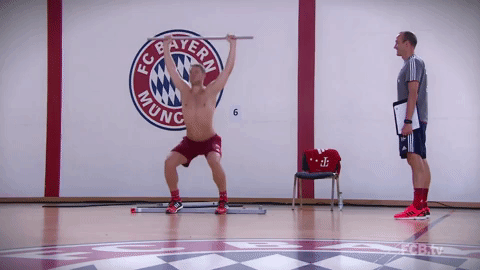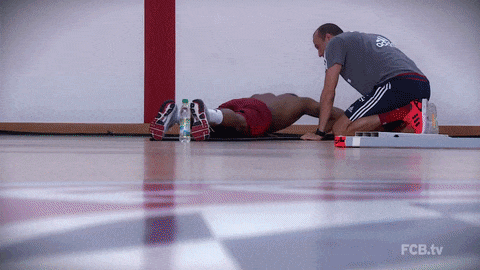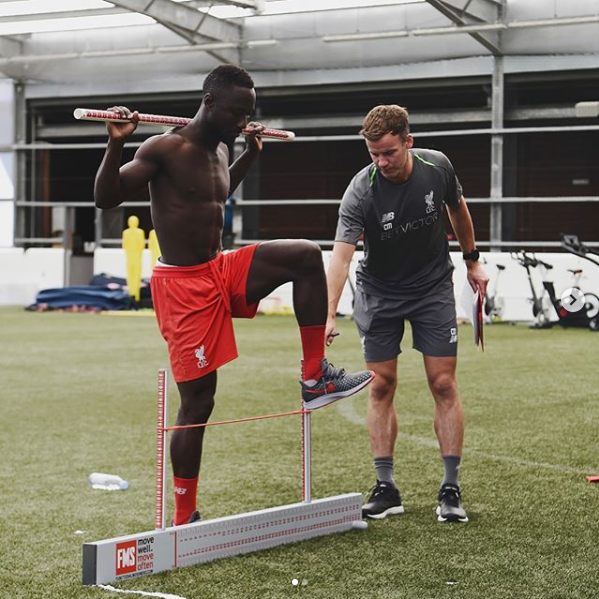Living On the Edge
Posted by Casey Stutzman

The FMS is broadly used in soccer, from the MLS to the EPL. Popular teams like LA Galaxy, Liverpool FC, and Bayan Munich began their season the same way: FMS screening (above LA Galaxy star striker Zlatan Ibrahimović performs the Deep Squat and ASLR).
Unlike the NFL which benefits from deep rosters, practice squads and a “next man up” mentality due to a near 100% injury rate, soccer only fields 11 - 14 players per game and a single injury can completely derail a season. For top soccer clubs, exhorbinant transfer fees and guaranteed contracts elevate the need for individual evaluation. Additionally, clubs have massive junior programs (essentially farm systems) so they are able to monitor and improve movement of some athletes throughout their entire playing career, from adolescence to adulthood.
While collision sports like American football are presumed to be the most injury prone, soccer isn't far behind. A 2006 study found that boys’ and girls’ soccer had the 3rd and 4th highest injury rate among high school sports, trailing only football and wrestling. The majority of soccer injuries involve the lower extremities, specifically the ankle and knee.
While many of the screens in the FMS don’t mimic movements on the pitch, analyzing a soccer player's performance in the screen can provide useful insight into how they move.
As in other sports, the FMS is utilized as a return to play protocol and in preseason testing to evaluate readiness to train and perform. Said FMS Certified strength coach Darcy Norman, “it allows the medical staff and fitness staff to have similar lines of communication with regards to what that player needs for their performance. It also creates a platform to have better conversations with a player on why they are moving the way they are moving and how improving the way they move will help their performance.”

(Bayern Munich Goalkeeper Manuel Neuer performing the deep squat)
In 2011, FMS Certified strength coach Ben Yauss wrote a terrific piece about why the LA Galaxy use the FMS. In it, he outlined how the FMS can help identify
One of the most common errors we see with the Deep Squat is the players’ inability to sit into their hips and the tendency to drive their knees forward. When the knees are in front of the toes, all the weight and forces go straight into the knees and prevent the hips and glutes from functioning the way they should. When we see this from the players, we have a number of corrective exercises in the gym and on the pitch that we have them perform to help correct the problem.
When decelerating on the pitch it is very important to let the hips and not the knees do the majority of the work. If a player drives his knees forward during the Deep Squat screen, we might see some of those same issues when starting and stopping on the field.

FMS Certified Brad Papson is the physical therapist for the MLS' Philadelphia Union. He wrote about the importance of using the FMS and SFMA to build more appropriate rehab and training programs for soccer players:
The FMS is commonly utilized at the end of an athlete’s rehabilitation to determine their “readiness” to return to sports. While it does not have any direct correlation to playing a sport, it does provide insight into an athlete’s movement patterns. The screen will provide the athlete with a breakdown of their movement patterns and those that need continued correction to help improve durability.
During the rehabilitation process, the Selective Functional Movement Assessment (SFMA) can decipher functional versus dysfunctional movement patterns that may have an influence over the athlete’s pain. Corrective exercise strategies may be used to help return to functional patterns.
Once the rehabilitation phases move out of the pain cycle, the Functional Movement Screen can be useful to provide the athlete with a better understanding of their movement profile.
When trying to get an athlete back onto the playing field, there are multiple rehabilitation keys. Pain and proper movement are not always related. Once we get pain under control, are we making sure that these athletes are moving properly in order to return to the field?
Proprioception, more simply stated as your awareness of your body in space, is a major component of one’s balance, and body control, namely motor/muscular, are imperative in the return to play continuum. All too often, that seemingly innocuous mild ankle sprain becomes recurrent. Approximately 30-40% of ankle sprains become recurrent. Following the snowball effect, that mild ankle sprain results in a loss of motion, which in turn can become a predictor of a knee injury. It's impossible to prevent something like a non-contact ACL injury, but you can see how insufficient rehabilitation can elevate risk factors associated with knee injuries.
We need to be looking at regaining the balance of stability and mobility. Gray Cook and Mike Boyle discussed the ideas of their Joint-by-Joint approach to analyzing movement patterns. Without trying to do them a disservice by oversimplifying, I summarize their theory: we need to assess how each joint works on/with the next in line. The foot needs stability, ankle mobility, knee stability, hip mobility/stability, lumbar spine stability, thoracic spine mobility, scapulothoracic stability, and glenohumeral mobility. As you can see, each joint needs to have certain characteristics in order for the next joint in line to perform optimally.

It ties directly into regional interdependence, where “seemingly unrelated impairments in a remote anatomical region may contribute to, or be associated with, the patient’s primary complaint” (Wainner). Imagine if you throw a rock into a pool, that large splash at impact precedes a ripple effect throughout the rest of the pool. In the same way, improper mobility at the ankle is going to have a huge effect on the knee, followed by a smaller impact at the hip, and progressively smaller impacts throughout the rest of the body.
Soccer is a high demand activity requiring an equally demanding rehabilitation. A lot of time is spent on one foot, running, and jumping. These activities can be and need to be practiced in therapy prior to returning to sports order to make sure they are not impaired. It is imperative that you seek a therapist that is going to provide careful attention to such details when you are recovering from an injury.
Neuromuscular Training Methods (NMT), built on dynamic stretching, motor control, agility, and plyometric training, have become trendy with great reasoning. 15-20 minute warm-up programs, easily adaptable for practice and pre-game routines, have a significant impact on an athlete's readiness and durability.
The PEP program, started by Santa Monica Sports Medicine Foundation, has a 2-year study showing a one year 88% decrease in ACL injuries and two year 74% decrease in ACL injuries among 3,000 female soccer players aged 14-18.
FIFA has developed an NMT program readily available to the public. The FIFA 11 (www.fifa.com) offers training programs aimed at improving soccer players' durability in a soccer-conditioning program with a secondary goal to improve performance. A study on the program "suggests that the FIFA 11+ exercise-based warm-up programs can both decrease the incidence of injuries in male and female amateur football players and also improve motor/neuromuscular performance."
A NMT program developed by Dr. Cynthia LaBella, showed a 44% decrease in non-contact lower extremity injuries and a 34% decrease in non-contact ankle sprains, while Canadian researchers found a NMT program cut the injury rate in half for 13-18-year-old soccer players.
Overall, a thorough system will not only assess the athlete’s current injury, but it will also utilize the most current evidence-based practice available to make sure the first injury is fully recovered. This system will include a full body movement analysis, risk assessment, functional training/testing, educational materials, and should be tailored to provide a lasting exercise program to make weaknesses strengths and strengths stronger.
Ultimately, “hindsight explains the injury that foresight would have prevented.” Let us work together to eliminate the games that are lost.
Posted by Casey Stutzman
Posted by Gray Cook
Posted by Gray Cook